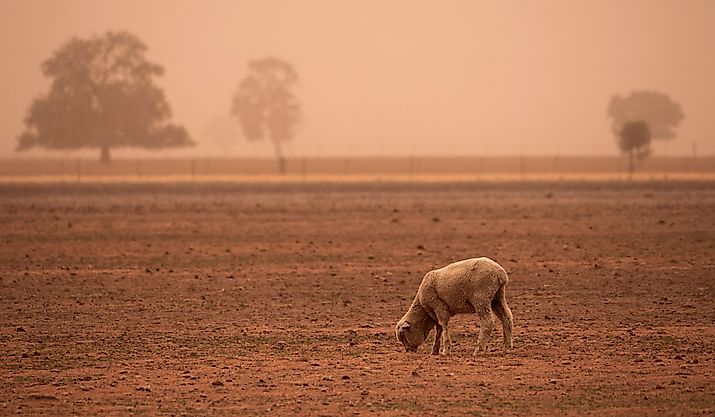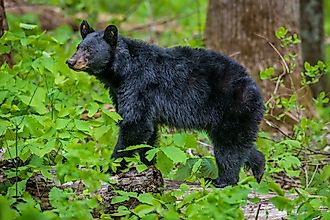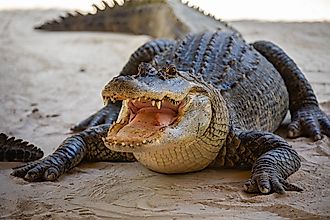Science & Nature

The 10 Deadliest Animals in Iowa
These ten deadly animals found in Iowa are important to lookout for, particularly the brown recluse spider, the copperhead snake, and more.
The 13 Deadliest Animals in New York
From the Massasauga rattlesnake to American black bears, learn more about some of the deadliest animals in New York's countryside and backwoods.

The 12 Deadliest Animals in Connecticut
Discover Connecticut's 12 most dangerous animals, learn what makes them harmful, and learn how to prevent a potentially tragic encounter.

Which State Has More Venomous Snakes: Texas or Louisiana?
Both Texas and Louisiana are located on the Gulf Coast and are home to various venomous snakes; however, which state has more?

The Most Snake Infested Lakes in New Jersey
Whether you are a nature enthusiast, a herpetologist, or just curious, discover some of the most snake-infested lakes in New Jersey.

The World's Costliest Earthquakes
While the loss of human life is always the main concern of any natural disaster, it is often the case that the economic toll is just as severe.

South America's Battle With Droughts That Cause Wildfires
Due to dry spells and rising temperatures, South America is experiencing unprecedented and massive wildfires, which are causing widespread concern.
Is The Panama Canal Going To Dry Up?
This article posits the idea of whether or not the Panama Canal will dry up, while also giving a brief history on the canal and its significance.

Australia's Struggle for Water Security
Australia has been hit with extreme droughts driven by climate change, which have deeply affected farmers, local animal species, and the economy.
The 11 Deadliest Animals in Tennessee
These are the 11 deadliest animals in the state of Tennessee, from slithering snakes with toxic venom to large mammals with a vicious temper.


The 10 Deadliest Animals in North Carolina
Discover the ten deadliest animals found in North Carolina, from venomous spiders and snakes to intimidating reptiles such as alligators.

How Does Mars' Gravity Affect Our Oceans?
By studying Earth’s ocean currents, researchers have found that the strength of the tide overlaps with the gravitational relationship between Earth and Mars.

The 13 Deadliest Animals in Oklahoma
Oklahoma is home to several poisonous, venomous, or territorial animals that can cause injury, and in some cases, death. Discover the deadliest in the state.
The 10 Deadliest Animals in Massachusetts
Massachusetts is home to these ten deadly animals, including the deer tick, red foxes, black bears, timber rattlesnakes, and more.
Titanosaurs Are the Largest Animals to Ever Roam Our Planet
The Titanosaur was one of the largest animals to ever roam the planet, reaching an immense length of over 100 feet over 100 million years ago.
Why Are Canada's Glaciers Causing A Drought?
Canada's glaciers make up a big chunk of the ice in the Arctic Circle, and their recession threatens the freshwater supplies essential for regional survival.
The Most Snake Infested Lakes In Utah
Some snakes like to live in or near the lakes and reservoirs and often give a fright when encountered. Here is a list of 7 of Utah's most snake-infested lakes
The Most Snake Infested Lakes in Delaware
Several lakes in Delaware, such as Trap Pond, Silver Lake, Red Mill Pond, and others, have snakes, such as the eastern ribbon snake.
Boa Snake, Initially Thought to Be Male, Gives Birth to 14 Babies in Rare Event
A misclassified male Brazilian rainbow boa named Ronaldo gave birth to 14 snakelets through rare parthenogenesis at the City of Portsmouth College.
The 12 Deadliest Animals in Illinois
Illinois is home to various dangerous animals, including venomous snakes, aggressive mammals, and disease-carrying insects.

The 12 Deadliest Animals in Delaware
These animals found in Delaware have a wide variety of prey, and some animals, such as lone star ticks, can pose a serious threat to people.

Astronomers Detect Massive Black Hole Awakening in Real Time
A sudden burst of light in galaxy SDSS1335+0728 reveals a potential massive black hole's awakening, captivating astronomers.

Why We Can't Avoid Singularity Inside Every Black Hole
Black holes are one of the most fascinating phenomena in the universe, and at their heart lies something even more puzzling—a singularity.

Top 11 Largest Spiders in the World
Discover the world's top 11 largest spiders, from the Goliath Bird-eating Tarantula to the Sand-dwelling Huntsman Spider.

How Much Water is in Earth's Crust?
Along with the 71% of water covering the Earth's surface, there are also millions of cubic miles hidden beneath the crust.

10 of the Fastest Snakes in the World
These ten snakes are some of the fastest in the world, using unique slithering and movement methods to hunt prey and get away from predators.

Where Do Most Earthquakes Occur?
Discover the world's three most active earthquake locations: Ring of Fire, Alpide Belt, and the Mid-Atlantic Ridge, and learn about tectonic plate movement.

The Deadliest Earthquakes Of The 21st Century
Countless destructive and deadly earthquakes have taken place during the 21st century. The worst of which took place in the Indian Ocean in 2004.

Which Countries Have the Least Natural Disasters
The WorldRiskIndex estimates a country's natural disaster risk by using 28 indicators instead of just looking at the chance of a natural hazard event.
What Causes Earthquakes?
Exploring the science behind earthquakes: the shifting of tectonic plates, seismic activity, and the factors contributing to earth's powerful tremors.
5 Human Activities That Can Cause Earthquakes
Learn how human activities like mining, fracking, water disposal, dam construction, and geothermal energy production trigger seismic events worldwide.

The World's Largest Birds
Embark on a thrilling expedition into the realm of the world's largest birds, where you'll encounter incredible species like the rhea, turkey, and albatross.
What Were The World's Deadliest Earthquakes?
Earthquakes have always been one of the most catastrophic events humans can endure. No matter what period, the threat of massive quakes always remains.

15 Animals Only Found In The United States
Explore and learn about the 15 most interesting animals that are endemic to the United States, from the Red Wolf to the tiny Bobtail Squid.

Are There Copperhead Snakes In The Everglades?
The only region of Florida with native populations of copperheads is the Panhandle. Specifically, they tend to stick to the Apalachicola River Basin.

10 Most Dangerous Plants in Florida
These 10 plants found in the Sunshine State of Florida are known for their poison and toxicity, making them very dangerous for humans.

The Biggest Earthquakes In US History
Learn about the United States' 10 biggest earthquakes, the aftermath, and preventative measures the country enacted as a result.

8 Most Dangerous Plants In Arizona
Some of these plants produce toxins that can cause severe reactions upon contact or ingestion, while others are capable of inflicting physical injuries.
